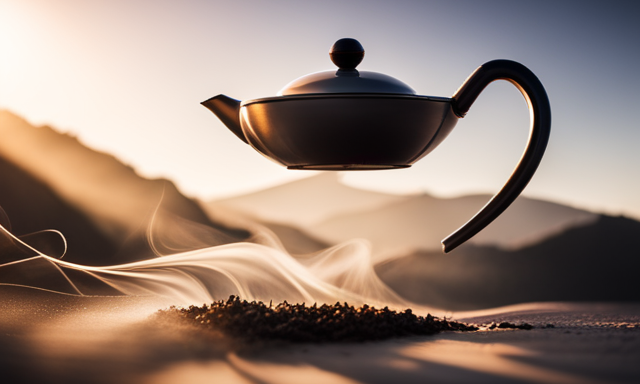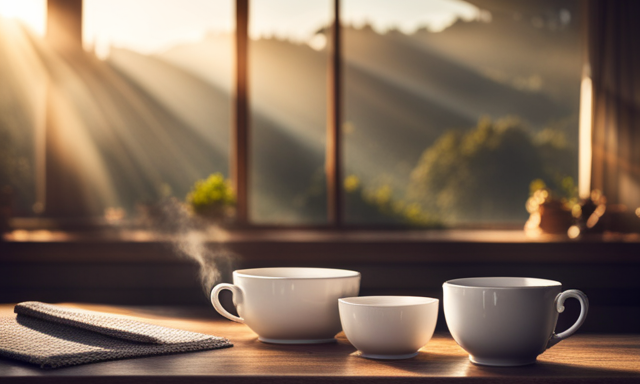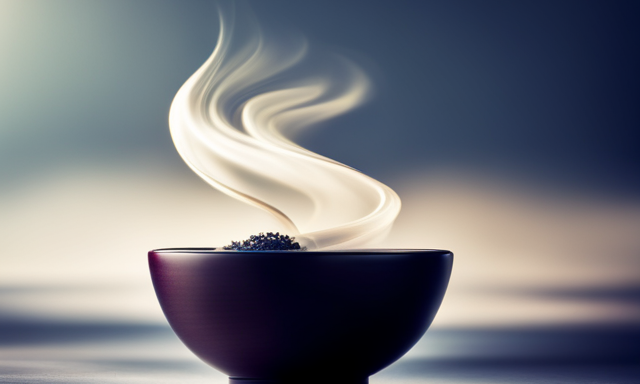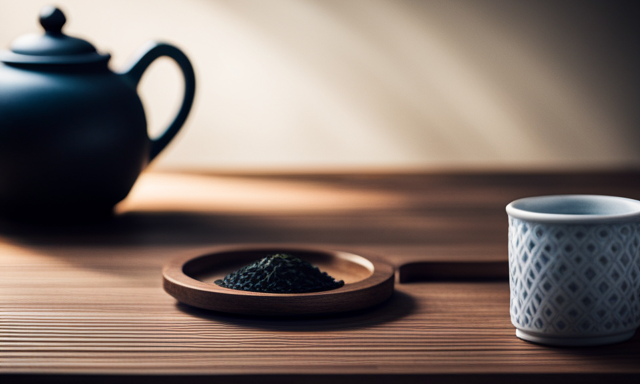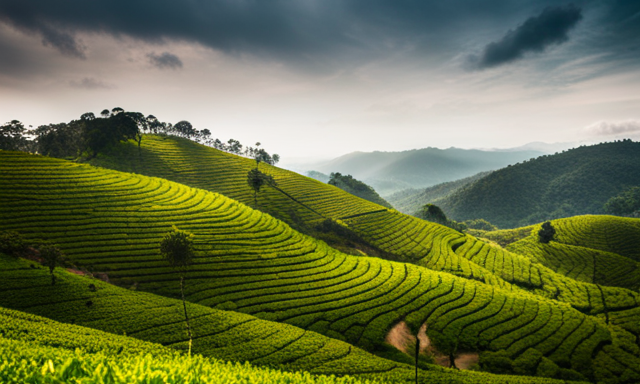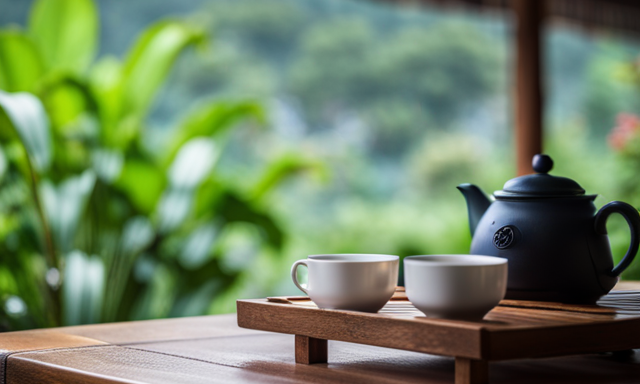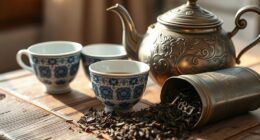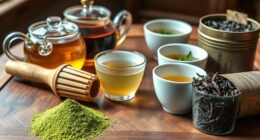As a tea enthusiast, I have always been captivated by the enchanting world of oolong tea. With its delicate balance of flavors and enticing aroma, each sip offers a journey of discovery. But have you ever wondered just how many times you can steep oolong tea?
Join me as we embark on a quest to unravel the secrets of this exquisite beverage. In this article, we will delve into the art of steeping oolong tea, exploring the process and unveiling the hidden depths of flavor.
From the initial steep that awakens our taste buds to the fifth steep that pushes the boundaries for stronger brews, we will push the limits and experiment with extended steeping.
Along the way, we will also uncover the factors that affect the steeping process, such as temperature, water quality, and tea varieties.
So, grab your teapot and let’s embark on a journey of tea-steeping mastery.
Key Takeaways
- Experiment with different steeping times and temperatures to find the desired flavor profile in oolong tea.
- Lengthen the steeping time to release deeper and more intense flavors in oolong tea.
- Strive for a balance between temperature and steeping time to achieve the desired taste.
- Use a teapot or gaiwan to enhance the brewing process and fully release the flavors of oolong tea.
Understanding Oolong Tea: A Brief Introduction
Understanding Oolong Tea: A Brief Introduction
You might be wondering how many times you can steep oolong tea.
Oolong tea, with its rich history and numerous health benefits, is a semi-oxidized tea that originated in China. It falls between the categories of green tea and black tea, offering a unique flavor profile and a range of health benefits.
Oolong tea is known for its ability to aid in weight loss, boost metabolism, promote heart health, and improve mental alertness.
The steeping process of oolong tea is essential to bring out its distinct flavors and aromas.
In the subsequent section, we will explore how to prepare oolong tea and unlock its full potential.
Exploring the Steeping Process: How to Prepare Oolong Tea
To fully experience the rich flavors of oolong tea, start by preparing it using a precise and time-honored steeping process. Exploring steeping techniques is key to maximizing flavor extraction and ensuring a satisfying tea-drinking experience. Here are some steps to follow:
- Begin by heating water to the ideal temperature for oolong tea, usually around 185-200°F.
- Place the oolong tea leaves in a teapot or infuser, using approximately one teaspoon of leaves for every 8 ounces of water.
- Pour the hot water over the leaves and let them steep for 2-3 minutes for a lighter flavor, or 4-5 minutes for a stronger brew.
- Once the steeping time is up, strain the tea into a cup and savor the intricate flavors and fragrances.
By following these steps, you will unveil the initial flavors and aromas of oolong tea in the first steep, preparing yourself for a delightful tea journey ahead.
The First Steep: Unveiling the Initial Flavors and Aromas
Once the water’s heated to the ideal temperature, it’s time to let the oolong tea leaves work their magic. They unravel a symphony of flavors and aromas that captivate your senses.
The first steep of oolong tea reveals its initial flavors and aromas. It offers a delightful experience right from the start. As you take your first sip, you may notice a harmonious blend of floral, fruity, and earthy notes.
The aroma wafts gently, inviting you to delve deeper into the steeping process. Pay attention to the subtle nuances that emerge with each sip. The last drops of flavor linger on your palate.
For those seeking stronger brews, extended steeping is an option. However, keep in mind that factors such as tea quality, leaf-to-water ratio, and water temperature can affect the outcome.
By understanding and enhancing the steeping experience, you’ll be ready to explore the next section about the second steep. This is where the depth of flavor awaits.
Second Steep: Unleashing the Depth of Flavor
Indulge in the rich symphony of flavors and aromas that burst forth during the second steep. Immerse your taste buds in a tantalizing journey of depth and complexity as the leaves unfurl further. The oolong tea releases a new wave of flavors, different from the first steep.
To fully appreciate this depth, it’s crucial to master the art of tea steeping techniques. Here are four key steps to unleash the full potential of your oolong tea:
-
Extend the steeping time: Allow the leaves to infuse for a longer duration, usually around 1-2 minutes, to extract more complex flavors.
-
Increase the water temperature: Use slightly hotter water, around 190-200°F (87-93°C), to intensify the extraction of flavors.
-
Experiment with multiple infusions: Don’t be afraid to steep the tea leaves more than once. Each infusion reveals different layers of taste.
-
Observe the color transformation: Notice how the liquor evolves into a deeper hue, indicating the development of richer flavors.
Unleashing the full potential of oolong tea during the second steep allows you to delve deeper into its complexity. It prepares you for the next step: discovering subtle nuances during the third steep.
Third Steep: Discovering Subtle Nuances
As the leaves continue to unfurl, the third steep reveals a delicate dance of flavors, teasing the palate with subtle nuances that whisper secrets of the tea’s hidden depths.
Exploring tea leaves in their third infusion is a fascinating journey, as they begin to release even more complex flavors. This is the stage where the true character of the oolong tea shines through, enhancing flavor profiles that were previously unseen.
The third steep brings out floral notes, with hints of orchids and jasmine weaving their way into the brew. The taste becomes smoother and more mellow, while still maintaining a satisfying richness. The tea leaves seem to have a story to tell, and each sip unravels a new layer of their narrative.
With the third steep complete, we now move on to the fourth steep: extracting the last drops of flavor, where the oolong tea surprises us once again.
Fourth Steep: Extracting the Last Drops of Flavor
After savoring the subtle nuances of the third steep, it’s time to dive deeper into the oolong tea leaves and extract every last drop of flavor. With each subsequent steep, the challenge lies in maximizing the infusion and unlocking the full potential of the leaves.
The fourth steep is where the true artistry of tea brewing shines through. To extract the last drops of flavor, it’s important to extend the steeping time slightly. This allows the water to penetrate deeper into the leaves, coaxing out hidden complexities and intensifying the taste. As the oolong tea leaves unfurl further, they release a captivating aroma that fills the air.
In this phase, you may notice the taste becoming more robust and full-bodied. The flavors become bolder, yet still refined, showcasing the tea’s unique characteristics. As you continue to explore the fourth steep, you’ll discover a new depth and richness that lingers on your palate.
Now, let’s push the boundaries even further in the fifth steep, creating a stronger brew that will tantalize your taste buds.
Fifth Steep: Pushing the Boundaries for Stronger Brews
Explore the exhilarating realm of the fifth steep, where you’ll push boundaries and unleash a brew so strong it will leave your taste buds craving for more.
This is where true tea enthusiasts thrive, pushing the limits and experimenting with time to extract every last drop of flavor from the leaves.
As you embark on this journey, you can extend the steeping time even further, allowing the oolong tea to release its robust and intense flavors. The longer you steep, the deeper the infusion becomes, resulting in a bold and full-bodied brew that will awaken your senses.
Each sip becomes a symphony of flavors, with hints of floral notes and a lingering sweetness. But beware, for this adventure might not be for the faint of heart.
Beyond the fifth steep, experimenting with extended steeping opens up a whole new world of flavors waiting to be discovered.
Beyond the Fifth Steep: Experimenting with Extended Steeping
Embark on this daring journey of extended steeping, and push the boundaries of your tea experience to unlock a world of unparalleled flavors and complexities. As you venture beyond the fifth steep, there are two key factors that will pave the way to new tea horizons: experimenting with temperature and exploring different steeping times.
Here’s a list to guide you through this exciting exploration:
-
Temperature experimentation: Varying the water temperature can bring out different flavor profiles in your oolong tea. Try steeping at lower temperatures for a milder taste or higher temperatures for a bolder, more robust flavor.
-
Lengthened steeping times: By extending the steeping time, you allow the leaves to fully release their flavors, resulting in a deeper and more intense cup of oolong tea.
-
Finding the perfect balance: It’s important to strike the right balance between temperature and steeping time to achieve the desired taste. Experimentation is key to discovering your personal preference.
-
Document and compare: Keep track of your experiments, noting the temperature, steeping time, and taste. This will help you identify patterns and refine your brewing technique.
Now that you’ve delved into the realm of extended steeping, let’s dive deeper into the fascinating world of factors affecting steeping: temperature, water quality, and tea varieties.
Factors Affecting Steeping: Temperature, Water Quality, and Tea Varieties
Factors Affecting Steeping: Temperature, Water Quality, and Tea Varieties
One of the most crucial factors that can affect your oolong tea steeping experience is water temperature. Oolong tea requires a slightly higher temperature than green tea but lower than black tea. Ideally, the water temperature should be around 190-205°F (88-96°C) for optimal extraction of flavors.
Steeping time is equally important as it determines the strength and intensity of the brew. Generally, oolong teas should be steeped for 3-5 minutes, but this can vary depending on personal preference and the specific tea variety.
Experimenting with different water temperatures and steeping times can help you find the perfect balance that suits your taste buds.
Now, let’s move on to discovering some tips and tricks for enhancing your oolong tea steeping experience.
Enjoying Oolong Tea: Tips for Enhancing the Steeping Experience
To truly savor the rich flavors of oolong tea, try incorporating a dash of honey or a splash of milk into your steeped brew for an indulgent and delightful experience. These additions can enhance the aroma and add a touch of sweetness to your tea, creating a more enjoyable and satisfying steeping experience.
When it comes to steeping oolong tea, there are a few techniques that can help bring out the best flavors. Firstly, make sure to use water that is around 195-205°F, as this temperature range is ideal for oolong tea. Additionally, try using a teapot or a gaiwan to allow the leaves to unfurl fully and release their flavors. Experiment with different steeping times to find your preferred strength, but generally, oolong tea can be steeped multiple times, with each steeping bringing out different nuances of flavor. Finally, take the time to appreciate the aroma and flavors as you sip your tea, allowing yourself to fully immerse in the experience.
Engage in the steeping experience by:
- Experimenting with different steeping times
- Using a teapot or gaiwan to enhance the brewing process
- Appreciating the aroma and flavors as you sip
- Adding a touch of honey or milk for added indulgence.
Frequently Asked Questions
Can I steep oolong tea more than five times?
Yes, you can extend the steeping of oolong tea beyond five times. Oolong tea offers multiple steeping varieties, allowing you to enjoy its rich flavor and aroma through multiple infusions.
What are some tips for extending the steeping process beyond the fifth steep?
To extend the steeping process of oolong tea beyond the fifth steep, I recommend gradually increasing steeping time by 30 seconds each time. This allows the flavors to fully develop and intensify, resulting in a richer and more robust tea experience.
How does the water temperature affect the steeping process of oolong tea?
The water temperature has a profound impact on the steeping process of oolong tea. It can dramatically alter the flavor profile and intensity, as well as affect the duration of steeping, allowing for a more nuanced and satisfying tea experience.
Are there specific tea varieties that are better suited for multiple steepings?
Certain tea varieties, such as Tie Guan Yin and Da Hong Pao, are known to be better suited for multiple steepings. These teas have a complex flavor profile that develops further with each steeping, making them ideal for experiencing the full range of flavors.
What are some common mistakes to avoid when preparing oolong tea for steeping?
Common mistakes when preparing oolong tea include using water that is too hot, steeping for too long, or not using enough tea leaves. Proper preparation techniques involve using water around 190°F and steeping for 2-3 minutes.
Conclusion
In conclusion, steeping oolong tea is a journey of discovery and exploration. Each steep reveals new layers of flavor and aroma, like unlocking the secrets of a hidden treasure.
With each sip, you delve deeper into the rich tapestry of oolong tea, uncovering subtle nuances and pushing the boundaries of taste.
Just as a painter adds brushstrokes to create a masterpiece, each steep adds depth to your tea experience.
So embark on this sensory adventure and let oolong tea transport you to a world of exquisite flavors.

